If you find your daily commute something of a chore then here’s some good news: things are about to change for the better. Advances in autonomous systems such as object recognition, lightweight materials and propulsion are manifesting themselves in a host of new transportation solutions. These will transform not just the way we think about travel, but how we conduct business, and how and where we live our lives too. Just last month Mercedes-Benz launched its semi-automated city bus. The premiere of the CityPilot took place on a 20km-long route linking Amsterdam’s Schiphol Airport with the town of Haarlem and during the journey the driver was not required to steer, accelerate or brake. If a driverless bus sounds like an attractive prospect then welcome to the future of transport.
ELECTRIC VEHICLES
Central to the success of electric vehicles is battery technology and the battery in your laptop uses the same lithium ion chemistry as the current generation of electric vehicles. But it is a technology with significant room for improvement.
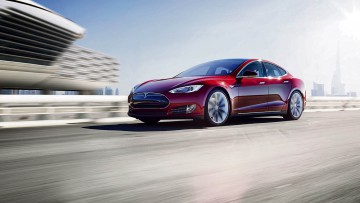
Tesla’s Model S all-electric saloon vehicle
Cosmin Laslau, energy storage senior analyst at Lux Research, says: “We can further cut costs and improve performance by another 20 to 40 per cent at least before the technology is done for. Until the early to mid-2020s, lithium ion is still the one to beat.
“In our view there are only two that really have a chance at deposing lithium ion in the next decade or so. The first are solid state batteries and the second are lithium sulphur batteries.”
David Greenwood, professor of advanced propulsion systems at WMG, University of Warwick, also highlights a number of likely contenders for the lithium-ion crown. “For applications where you need a lot of energy, but you’re not particularly sensitive to the volume of the battery, the kind of thing going into say trains, then the lithium sulphur family of chemistries is quite interesting. Some of the lithium air families of chemistry are showing some very good energy density and we have sodium ion rather than lithium ion,” says Professor Greenwood.
AUTONOMOUS SHIPPING
Crewing a marine vessel is expensive and it’s not just a matter of wages. Ships have to be designed to accommodate crew and equipped with cabin space, heating, ventilation, lighting, and the provision of food and drink for a long voyage. The possibility of more efficient ship designs is one reason why autonomous vehicle technology is also coming to the marine sector.
As Oskar Levander, vice president of innovation in the marine division at Rolls-Royce, says: “This is happening. It’s not if, it’s when.” Mr Levander was speaking at the first Autonomous Ship Technology Symposium in Amsterdam in June, but autonomous marine vessels already exist.
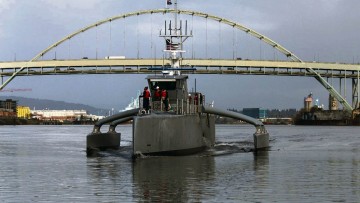
Prototype of Sea Hunter, an autonomous antisubmarine vessel, being trialled by DARPA
A number of smaller navy vessels are in service or are under development. For example, the 132ft Sea Hunter, an autonomous anti-submarine vessel, is being trialled by the US Defense Advanced Research Projects Agency following its launch in May.
Rolls-Royce is working with VTT Technical Research Centre of Finland on its Advanced Autonomous Waterborne Applications Initiative, in which a land-based control centre with a small crew monitors and controls a fleet of autonomous vessels across the world.
As VTT senior scientist Mikael Wahlstrom explains: “You have flying drones already, you have the satellites and you have object recognition. You don’t need technological breakthroughs anymore.”
HYPERLOOP
A radical new concept for the high-speed transport of people and cargo is the Hyperloop. The system is based on a magnetic levitation vehicle operating in a vacuum tube and driven by an electric linear motor.
But perhaps more significant, without air resistance such vehicles are expected to travel close to the speed of sound – faster than a commercial jet aircraft.
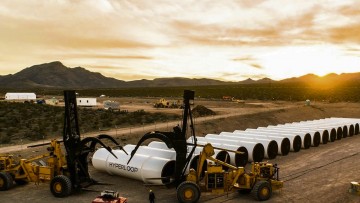
Test site for the Hyperloop electric propulsion transport system
Rob Lloyd, chief executive at Hyperloop One, says: “We see Hyperloop as a new mode of transportation something that follows on with equal or greater impact than what we saw with trains and the individual mobility that was enabled by the automobile.”
Mr Lloyd highlights breakthroughs in tunnelling technology as one of the keys to Hyperloop development, and with the commissioning of the world’s longest and deepest rail tunnel due later this year – the 57km-long Gotthard Base Tunnel between Switzerland and Italy runs up to 2.3km deep – he emphasises the reality of Hyperloop technology.
“We’re building the first prototype system; we’ll demonstrate that to the world in the early part of 2017. We expect that we’ll begin construction in 2017 and 2018 of the first production Hyperloops, probably freight first, passengers second, coming to fruition in 2020 for freight and 2021 for passengers.”
AUTOMOBILITY OFFICE
As confidence in driverless vehicles grows, new phases of automobility are anticipated. One concept explored by design consultancy IDEO considers the inverse commute: working spaces that will come closer to where people live instead of commuters heading to work at a fixed urban location.
Interlocking pods that could be configured for specific requirements would navigate to a pre-determined location, say a transport hub like a railway station or airport, perhaps at a location between two teams.
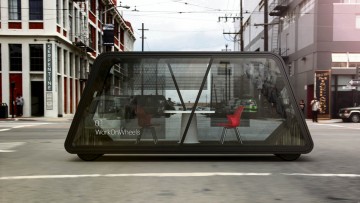
Mobile working space concept by IDEO
Luis Cilimingras, managing director of IDEO’s London studio, explains: “These are not self-driving offices; they were never intended to be places people work in while they’re moving. Instead, they’re making a workplace much more flexible because they can be parked anywhere.
“The future of a much more creatively productive workforce is also a much more flexible workforce and this is starting to loosen our dependence on real estate. But the time that you need to spend with a team, face to face, is still absolutely necessary and very precious – the inverse commute concept addresses that.
“The number of parking spaces we’re going to need is dropping because there are fewer cars being owned privately and there’s much higher utilisation of cars. Peak areas become vacant and they could become places where these driving offices settle,” says Mr Cilimingras.
PERSONAL AERIAL VEHICLE
The idea of a flying car is at least as old as powered flight, but breakthroughs in a number of technological areas are now expected to make that dream a reality. “The level of technology available – carbon fibre, lightweight materials or power density of the new engines – allows us to design and develop an entirely new type of efficient vehicle,” says Stefan Vadocz, of Slovakia-based AeroMobil.
AeroMobil is already trialling its 3.0 prototype, a two-seater flying roadster. “Our plan is to commercialise AeroMobil in 2017, with manufacturing in 2018,” says Mr Vadocz. “We believe the category of vehicles which is often referred as a flying car or a personal aerial vehicle (PAV) will be a natural extension or alternative to the set of cars, aeroplanes and helicopters we use today.”
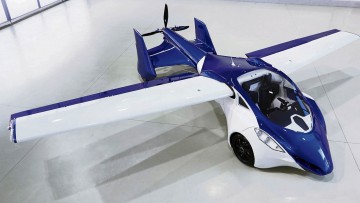
Tesla’s Model S all-electric saloon vehicle
He is not alone in this belief, several companies are now looking to commercialise PAVs in the coming decade, among them are outfits reportedly backed by Google founder Larry Page.
Initially a niche product aimed at buyers of new technology, supercars and small aeroplanes, it will be followed later with vehicles for wider public use and could be offered through transportation-as-a-service scenarios, possibly as a shared or fractionally owned vehicle.
“AeroMobil can become an inspiration and a new stage in the future of personal transportation,” Mr Vadocz concludes.
SPACE FLIGHT
Advances in space technology have already transformed transportation with the advent of satellite navigation. However, the next generation of space tech could open the heavens to all of us.
A host of privately funded space ventures are busy developing technologies that will not only open up the possibility of low-cost, sub-orbital space travel to individuals, but also to those wishing to deploy space technology.

First powered flight of Virgin Galactic’s SpaceShipTwo over the Mojave Desert in 2013
As Virgin Galactic boss Sir Richard Branson says: “The future will see many sustainable space businesses that improve livelihoods, bolster communities and grow economies. We created Virgin Galactic to open access to space.
“By lowering the cost of flexible, reliable and dedicated flights to orbit for small satellites, we are creating an opening for satellites from emerging designers that feature their fresh take on engineering possibilities.
“Like other technologies, with practice we will be able to make our forays to space cheaper and more frequent while increasing performance.”
Like Virgin, XCOR Space Expeditions is offering seats aboard its Lynx craft on future space missions, while Elon Musk’s SpaceX has struck a deal with Nasa to transport astronauts aboard its Dragon craft. In 2012, Dragon became the first commercial spacecraft to deliver cargo to the International Space Station.
ELECTRIC VEHICLES

AUTONOMOUS SHIPPING

